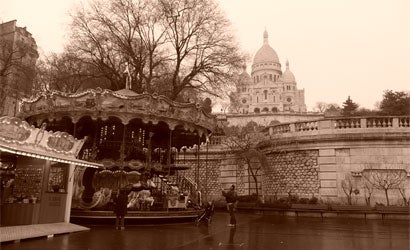How to Make the Best of a Bad Shooting Situation
It was a rainy day in Paris. I was in the City of Lights, along with other members of the...

It was a rainy day in Paris. I was in the City of Lights, along with other members of the international photo press, for the debut of Panasonic’s latest cameras. I was shooting with the new $349 (estimated street) Lumix DMC-TZ3, which the manufacturer bills as the perfect traveling companion– pocket-sized but packing 7.2MP, a 10X zoom that starts at a wide 28mm equivalent, image stabilization, and a 3-inch LCD.
But for all that, it couldn’t do anything about the rain. Every shot looked dull; even reflections on the wet pavement fell flat. Bad photos of Paris, it is possible? It seemed so.
Then Jerry Grossman of the trade paper, Photo Industry Reporter, held up the LCD of his camera. He’d taken a few images in Sepia mode, and the pictures looked much better than anything shot in color. There was a mass switch to sepia. Granted, not the most sophisticated solution, but it was an idea that helped turn this photo op around.
It’s the kind of situation all of us face with our photography — the weather, the lighting, or the subject may not be cooperating, or you don’t have all the time or gear you’d like, but you still have to get good shots. What do you do? Get creative and find workarounds. Here are some solutions for situations that have the makings of photo disasters.
• The Situation: You’re suddenly appointed the party photographer.
The Problem: All you have is a digital compact, and the tiny flash won’t properly light — let alone flatter — the guests. Also, capturing tequila-fired red noses isn’t going to get you invited next time.
The Solution: Shut off the flash and switch to black-and-white mode. Yes, the ISO will go through the roof, but in b&w, the digital noise looks like grain. Sort of arty. And chances are, monochrome will be more flattering to all of the revelers.
• The Situation: A friend asks for a spur-of-the-moment portrait.
The Problem: Your subject has horribly blotchy skin.
The Solution: High key. That is, overexpose the shot to drain the detail out of the skin. Digital cameras not only let you use the LCD to see how much overexposure is needed as you bracket (start at a half-stop and work up), but today’s sensors also are very good at holding shadow detail while blowing out the highlights in a shot. Which is exactly what you want.
• The Situation: Aunt Rhodie cooked a delicious roast goose that everyone wants to remember.
The Problem: The bird doesn’t look as good as you hope it will taste.
The Solution: Shallow depth of field. Go with the widest aperture you can, and focus on that gorgeous sprig of parsley atop the carcass. That’s about all that will be sharp. The rest of the image will have that soft, dreamy look so popular in the food magazines from which Aunt Rhodie gets her recipes.
Ask John.Q. When will there be a true 3D digital camera?
A. It might be a while. In the meantime, Microsoft is working on 3D software called Photosynth. It looks at all sorts of pictures of an object or place and reconstructs them into a 3D package–like panoramastitching software, only more sophisticated and less fussy about the photos it uses. You can’t buy it — yet — but there’s a demo at labs.live.com/photosynth.